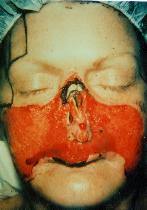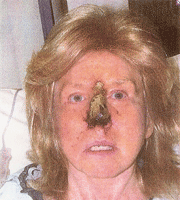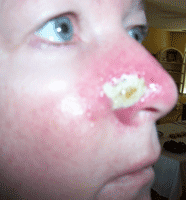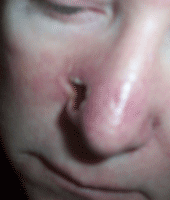Don't Use Corrosive Cancer Salves (Escharotics)
Stephen Barrett, M.D.
Many salves, pastes, poultices, and plasters have been applied directly to tumors with the hope of burning them away. Zinc oxide, bloodroot, and several other herbs are common ingredients. Some marketers claim that corrosive agents (sometimes called "black salves") can "draw out" the cancer. In recent years, scientists have found chemicals that can destroy certain superficial skin cancers. Except for these, however, corrosive agents are worthless against cancer and cannot be legally marketed for that purpose in the United States.
Corrosive salves are often referred to as "escharotics" because they produce a thick, dry scab called an "eschar" on the skin. Their use to treat cancer dates back hundreds of years, perhaps even to ancient times. Their use was fairly common during the 18th and 19th centuries. If a tumor is confined to the superficial layers of the skin, it would be possible to burn it off with a corrosive salve or paste. Unfortunately, products capable of accomplishing this can also burn the surrounding normal tissue and result in unnecessary scarring. For superficial cancers—for which the cure rate with standard treatment is nearly 100%—it makes much more sense to use standard methods that can destroy the cancer with little or no damage to the nearby tissues. Some salves are also promoted for treating herpes, venereal, diseases, diabetes, and lupus.
| The danger of using these products is illustrated by the experience of Ruth Conrad, an Idaho woman who consulted one of the state's many unlicensed naturopaths in 1984. While seeking treatment for a sore shoulder, she also complained of a bump on her nose. The naturopath stated that it was cancer and gave her a black herbal salve to apply directly. Within a few days, her face became very painful and she developed red streaks that ran down her cheeks. Her anxious phone call to the naturopath brought the explanation that the presence of the lines was a good sign because they "resemble a crab, and cancer is a crab." He also advised her to apply more of the black salve. Within a week, a large part of her face, including her nose, sloughed off. It took 3 years and 17 plastic surgery operations to reconstruct her face. During a deposition, the naturopath stated that he had obtained the salve from a woman in Mexico and that he didn't know who had manufactured it. The picture shows the extent of the injured area. | 
|
The idea that products applied to the skin "draw out" the cancer" beneath them is preposterous. Furthermore, even if a product could do this, it could not influence cancers that have spread (metastasized) to distant regions of the body.
Because cancer salves are not manufactured under government supervision, it may not even be possible to know what is in them. People who use such products without benefit of medical consultation run additional risks. Untrained individuals may incorrectly conclude that a growth is cancerous when it is not. In addition, skin cancers that can spread should be medically investigated to see whether they have done so, and some of these require extensive treatment even though they might not look dangerous to the naked eye.
Regulatory Actions
Salves intended for the treatment of cancers cannot be legally marketed. The FDA has banned the importation of all "black salve" products, including Cansema Black, Topical Salve, Cansema Deep Tissue, Cansema w/Lugol's Iodine (topical), Cansema for Cats, Dogs, and Horses, Cansema Tonic I, Cansema Tonic II, Cansema Tonic III, Cansema Capsules, Cansema Suppositories, Bloodroot Paste, C-Herb Paste, CAN-X, Cancerx, H3O, and Healing Formula [1].
In 2004, Gregory James Caton, of Lake Charles, Louisiana, was sentenced to 33 months imprisonment to be followed by 3 years supervised release for marketing several products with claims that they could cure cancer and other diseases. Court documents indicate that from 1999 to 2003, doing business as Alpha Omega Labs, Caton and his employees sold Cancema Tonic III (a purported cancer cure) and H3O (claimed to be effective against athlete's foot, cuts and burns, eczema, fingernail fungus, chronic gas, gastroenteritis, gingivitis and periodontal disease, halitosis, herpes sores, ophthalmia, psoriasis, sore throat, strep throat, and wounds) [2].
In April 2005, the FDA ordered Two Feathers, Inc., of Reno, Nevada, to stop marketing an escharotic salve called Two Feathers [3]
Later in 2005, Lois March, M.D., an ear, nose, and throat specialist who practiced in Cotrell, Georgia, has surrendered her medical license to settle charges that she improperly helped Dan Raber, an unlicensed person who treated patients for cancer. Georgia’s Composite Board of Medical Examiners had accused March of providing pain management to several patients whom Raber treated with a bloodroot paste, including one man whose flesh was eaten so badly from his shoulder that the bone was exposed [4]. Press reports indicate that the FDA raided Raber's farm.
In April 2006, the FDA ordered Risingsun Health Alternatives and Herbs, a division of MacAdam Health Enterprises of Livingston, Montana, to stop its illegal marketing of Cansema products [5].
Advocacy by Andrew Weil
Andrew Weil, M.D., who promotes himself as "your trusted health advisor," has been a strong proponent of bloodroot paste. His 1995 book Spontaneous Healing states that after reading a letter from a user he "was able to find a number of references about its peculiar ability to dissolve abnormal growths on the skin without harming normal tissue." Six months later, when his dog got a black growth on his skin, he applied a bloodroot paste, noted that "the whole tumor" fell off after a few days, and concluded that the end result was "a perfectly circular, slightly depressed area of skin, with no trace of tumor." After trying it out on a friend, he began teaching medical students how to use it with outcomes that were "consistent and satisfactory." [6] Reading this account shortly after the book was published, I was struck by four things things:
- The idea that bloodroot kills only cancer cells and spares normal ones is preposterous.
- There was no mention of a biopsy, without which it might not be possible to be certain that his friend had a cancer.
- Weil does not mention how he determined that medical students who who followed his advice had "consistent and satisfactory outcomes." Some skin cancers that are left behind will not become apparent until months or even years after they are treated. Without a formal follow-up study, it is impossible to determine the long-term outcome.
- The naked eye cannot tell where the margin of a skin cancer is located because there can be microscopic spread beyond the obvious tumor. When simple surgery is performed, the surgeon removes the obvious area plus a small amount of surrounding tissue. If the pathology report shows no tumor at the specimen margins, it is assumed that the entire tumor has been removed. If cancer shows at the margins, further surgery is performed. Today, Weil's Web site acknowledges this point by stating "I do not recommend using bloodroot paste, or anything else for that matter, for the self-treatment of skin cancers. It might not get all malignant tissue. Only examination by biopsy can confirm a diagnosis or a cure." [7] However, even this statement is irresponsible because bloodroot paste is not a sensible treatment no matter who applies it. Nevertheless, for more than four years, Weil's Web site carried an article that plugged bloodroot and linked to four companies that would supply information and products [8].
Three More Victims
A recent book, Natural Causes, describes what happened after Weil's Web site persuaded Sue Gilliatt of Indianapolis, Indiana to use bloodroot products. According to the book, her primary care physician removed a bump on her nose that was diagnosed as a benign tumor called a fibroadenoma. But Gilliatt feared that it was cancerous and, even though she was given a referral to a dermatologist, wound up buying Cansema from the Alpha Omega Alpha Web site and a bloodroot paste from Dan Raber. The Cancema stung so badly that she was unable to keep in on for the recommended 24 hours and applied Raber's paste instead. Within a few hours after she applied it to her nose, her face became puffy and her eyes were nearly swollen shut. Instead of consulting her doctor, she phoned Raber who persuaded her to apply more paste. Six days later, when she had her appointment with the dermatologist, a large part of her nose had been destroyed.
Two other black salve victims have shared their stories with me:
| Gail Bumpus, of Singer Island, Florida, Florida, was the victim of 84-year-old Jerome Craft, M.D., a board-certified plastic surgeon who advertised in the Yellow Pages as a specialist in cancer and burns. In 2005, she consulted him about possible surgery for excess skin under her nose. During the first two visits, without taking a biopsy, Craft said that she had extensive cancer in the nose and that a black salve that he had invented would remove the cancer without leaving any scars. After the salve was applied, her nose became extremely painful and her face swelled "like a pumpkin." Although an emergency room physician advised hospitalization, Craft talked her into remaining under his care for ten more days, during which time she experienced excruciating pain but was reassured that she would be fine. When she finally returned to the hospital, she was admitted for five days and treated with massive doses of antibiotics. When the dead tissue was removed from her nasal area, it was apparent that her nose had been burned off. So far she has had six operations to reconstruct a nose. The Florida Board of Medicine has charged Craft with "failing to practice medicine with that level of care, skill, and treatment which is recognized acceptible and appropriate by reasonably prudent similar health care providers." [9] |

Appearance before |
 A few days after the salve was applied, most of her nose was destroyed. |
| In 2006, Paulette Teel, of Liberty Hill, Texas, developed a small but deep-rooted cancer on the skin of her nose that was biopsied and diagnosed by a dermatologist. Surgery was recommended, but her sister, who has practiced as a "master herbalist" for many years, persuaded her that a bloodroot paste would do a better job. The first picture shows how her nose and the surrounding skin became inflamed. The second picture shows the hole in her nose that resulted. The paste destroyed some areas of bone and cartilage, which means that when the wound heals, she will require extensive plastic surgery. She also reported that the inflamed area was extremely painful for more than a week. |  |
 |
Mohs Surgery
Mohs micrographic surgery is a state-of-the-art treatment for skin cancer in which the physician (usually a dermatologist) serves as surgeon, pathologist, and reconstructive surgeon. It begins with surgical removal of the visible tumor and microscopic examination of the specimen. If cancer is seen at the margins, the suspected area plus a thin margin i 99 [9]s removed and the process is repeated until it appears that all of the cancer has been located and removed. The end result is a very high cure rate (over 99% for new cancers and 95% for recurrent cancers) with minimal removal of healthy tissue [10].
The Bottom Line
Skin cancers should be medically diagnosed and treated. Those located in readily visible areas (eyes, nose, lips, or scalp) should be treated with Mohs surgery. The types of products described in this article are extremely dangerous. Their sellers deserve to be imprisoned.
References
- Import Alert #66-41: "Unapproved new drugs promoted in the U.S." Revised April 6, 2006.
- Lake Charles man sentenced for selling and shipping unapproved new drugs. USDOJ news release, Aug 24, 2004.
- Cassens BJ. Warning letter to Two Feathers, Inc., and Robert Roy. April 13, 2005.
- In the matter of Lois March, M.D. Before the Georgia Office of State Administrative Hearings. Filed July 26, 2005.
- Breen CM. Warning Letter to Greta Armstrong. April 6, 2006.
- Weil A. Spontaneous Healing. New York: Alfred A. Knopf, 1995, pp 48-51.
- Weil A. Bloodroot for skin cancer? Dr. Weil.com, Jan 9, 2006.
- Hurley D. Natural Causes: Death, Lies, and Politics in America's Vitamin and Herbal Supplement Industry. New York: Broadway Books, 2006.
- Complaint. Florida Department of Health vs. Jerome W. Craft, M.D. DOH case number 2005-03020, filed May 2, 2006.
- About Mohs micrographic surgery. American College of Mohs Micrographic Surgery and Cutaneous Oncology Web site, accessed December 12, 2006.
This article was revised on February 12, 2007.